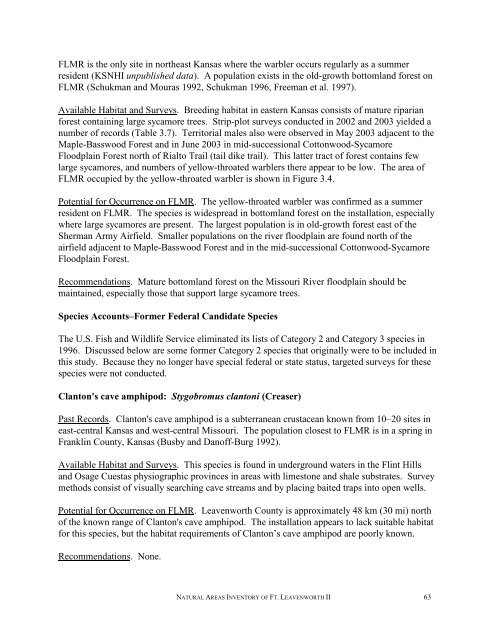A Natural Areas Inventory of the - Kansas Natural Heritage Inventory ...
A Natural Areas Inventory of the - Kansas Natural Heritage Inventory ...
A Natural Areas Inventory of the - Kansas Natural Heritage Inventory ...
Create successful ePaper yourself
Turn your PDF publications into a flip-book with our unique Google optimized e-Paper software.
FLMR is <strong>the</strong> only site in nor<strong>the</strong>ast <strong>Kansas</strong> where <strong>the</strong> warbler occurs regularly as a summer<br />
resident (KSNHI unpublished data). A population exists in <strong>the</strong> old-growth bottomland forest on<br />
FLMR (Schukman and Mouras 1992, Schukman 1996, Freeman et al. 1997).<br />
Available Habitat and Surveys. Breeding habitat in eastern <strong>Kansas</strong> consists <strong>of</strong> mature riparian<br />
forest containing large sycamore trees. Strip-plot surveys conducted in 2002 and 2003 yielded a<br />
number <strong>of</strong> records (Table 3.7). Territorial males also were observed in May 2003 adjacent to <strong>the</strong><br />
Maple-Basswood Forest and in June 2003 in mid-successional Cottonwood-Sycamore<br />
Floodplain Forest north <strong>of</strong> Rialto Trail (tail dike trail). This latter tract <strong>of</strong> forest contains few<br />
large sycamores, and numbers <strong>of</strong> yellow-throated warblers <strong>the</strong>re appear to be low. The area <strong>of</strong><br />
FLMR occupied by <strong>the</strong> yellow-throated warbler is shown in Figure 3.4.<br />
Potential for Occurrence on FLMR. The yellow-throated warbler was confirmed as a summer<br />
resident on FLMR. The species is widespread in bottomland forest on <strong>the</strong> installation, especially<br />
where large sycamores are present. The largest population is in old-growth forest east <strong>of</strong> <strong>the</strong><br />
Sherman Army Airfield. Smaller populations on <strong>the</strong> river floodplain are found north <strong>of</strong> <strong>the</strong><br />
airfield adjacent to Maple-Basswood Forest and in <strong>the</strong> mid-successional Cottonwood-Sycamore<br />
Floodplain Forest.<br />
Recommendations. Mature bottomland forest on <strong>the</strong> Missouri River floodplain should be<br />
maintained, especially those that support large sycamore trees.<br />
Species Accounts–Former Federal Candidate Species<br />
The U.S. Fish and Wildlife Service eliminated its lists <strong>of</strong> Category 2 and Category 3 species in<br />
1996. Discussed below are some former Category 2 species that originally were to be included in<br />
this study. Because <strong>the</strong>y no longer have special federal or state status, targeted surveys for <strong>the</strong>se<br />
species were not conducted.<br />
Clanton's cave amphipod: Stygobromus clantoni (Creaser)<br />
Past Records. Clanton's cave amphipod is a subterranean crustacean known from 10–20 sites in<br />
east-central <strong>Kansas</strong> and west-central Missouri. The population closest to FLMR is in a spring in<br />
Franklin County, <strong>Kansas</strong> (Busby and Dan<strong>of</strong>f-Burg 1992).<br />
Available Habitat and Surveys. This species is found in underground waters in <strong>the</strong> Flint Hills<br />
and Osage Cuestas physiographic provinces in areas with limestone and shale substrates. Survey<br />
methods consist <strong>of</strong> visually searching cave streams and by placing baited traps into open wells.<br />
Potential for Occurrence on FLMR. Leavenworth County is approximately 48 km (30 mi) north<br />
<strong>of</strong> <strong>the</strong> known range <strong>of</strong> Clanton's cave amphipod. The installation appears to lack suitable habitat<br />
for this species, but <strong>the</strong> habitat requirements <strong>of</strong> Clanton’s cave amphipod are poorly known.<br />
Recommendations. None.<br />
NATURAL AREAS INVENTORY OF FT. LEAVENWORTH II 63


